Celebrate the Catalog: Weezer

The third outing for Celebrate the Catalog is a contentious one, considering the widely held opinion that, following the release of their third album, there’s more to deride than celebrate in the discography of what is one of Alternative Rock’s most divisive bands. Weezer emerged somewhat awkwardly in the aftermath of Nirvana’s implosion, possibly originally eyed by both bands’ label Geffen as the Radio Friendly Unit Shifters that Nirvana (with the tumultuous gestation of In Utero) had shown a complete unwillingness to be. Rivers Cuomo & Co. embodied a PG version of the ‘grunge’ band — lovelorn, heart worn on the sleeve of their disintegrating letterman sweater, cleancut love songs, anchored by the erstwhile crunch of the fuzz pedal.
During a four-year hiatus at the end of last century, Weezer’s first two albums grew in stature, leading to a groundswell of new support prompting their return, who upon having their wish granted were presented with a rebooted facsimile, eschewing the heart-felt confessional air and feedback-inducing heavy rock riffs of second record Pinkerton for a back-to-basics approach that, even in 2001 among backward-looking bands like The White Stripes and Strokes, seemed regressive. In what has begun to seem like a deliberate attempt to do the exact opposite of what his fanbase wants or expects, Rivers Cuomo has taken previous accusations of oddballery to the nth degree, working with collaborators as universally reprehensible as Kenny G, Sugar Ray, Crazy Town and Katy Perry, and as lauded as Lil Wayne, Male Bonding, Best Coast and Julian Casablancas.
Last year, the band acknowledged the enduring demand for the first two albums and undertook a limited tour playing each in its entirety, while in the last month or so, rumors of a possible collaboration with Toro Y Moi have surfaced along with stage-sharing Flaming Lips shows, and a cruise including support from the perpetually credible Dinosaur Jr., Sebadoh, Gene Ween and Wavves. This dual allegiance to the extremes of music surely begs deeper interpretation to his immersions in the seemingly shallower recesses of their undeniably polarized body of work.
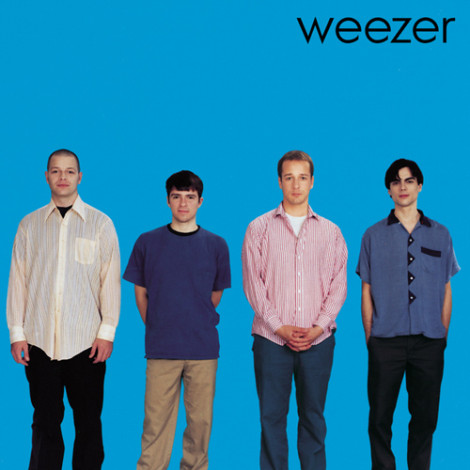 Weezer
Weezer
(1994, DGC/Interscope)
The record waltzes in with a misleading 3/4 time acoustic guitar intro before hitting you with the down-strum chug of distorted guitars that will become the calling card of Weezer’s irrepressible formative years. Unintentional though it may have been, a manifesto was written with this record that was never to be successfully repeated or truly adhered to. So long a shadow does it cast, that it’s difficult to know what to write about an album that is probably as at home in your record collection as your brain.
While “Undone (The Sweater Song)” was Weezer’s infectious introduction to the world, its perhaps “Buddy Holly” that so best crystallizes and defines them. Never before had a pop song so explicitly and unapologetically championed it’s singer’s honest-to-Arneson Geekiness. While its trinkets are now the currency of the cool kids, and the Geek has inherited the virtual earth, true Geekdom in popular music and culture was embedded by this record. Across its ten songs, the seemingly limited tools at this band’s disposable are somehow the perfect vessel for heavenly honed melodies and the riot of adolescent ideas contained within the lyrics. Cuomo’s naivety pays dividends in the listener’s empathic capacity to ebulliently relate with him, lending him the heft that will unfortunately spur him into myriad dalliances with questionable mutations of message’s medium in his later career…if indeed, later on, there is a message at all.
Rating: 9.9 out of 10
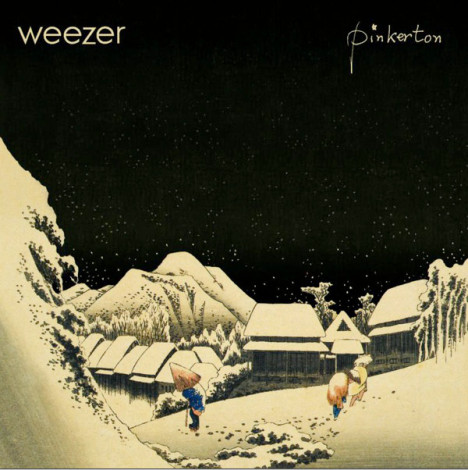 Pinkerton
Pinkerton
(1996, DGC/Interscope)
The follow-up to their eponymous debut was originally precociously envisioned as an allegorical Rock Opera set in a ‘Star Corps Academy’ in space, loosely based on Rivers Cuomo’s experiences of life in the meteoric rise of a Rock Band exploring strange new worlds on tour, as well as the opposite sex. Following an operation to extend his leg which left him for a spell with a walking stick and Percocet problem, the project was eventually re-conceptualized and pared-down to the Madame Butterfly-inspired Pinkerton.
With its 10 tracks, and sparsely arranged cover art, it’s Blue‘s shadow-self. Over the course of its 34 minutes, Rivers laments his inability to formulate a relationship with numerous different girls (these crushes you get the feeling, are running pretty much concurrently) with the same gawky openness as on it’s predecessor, but with darker, more lascivious results. The Rivers of ‘Blue’ is almost endearing in his idealism, which does border on misogyny but can be forgiven as you get the feeling he has the best of intentions, while the Rivers of Pinkerton is an unapologetically horny dork emboldened by Rock Stardom, wondering why the domestic objects of his affection don’t fawn over him like the 18-year-old author of the fan letter that makes up “Across The Sea.” Largely dismissed on its initial release, but later bestowed the dubious honor of having been the catalyst for modern Emo, Pinkerton has amassed a cult following for it’s more abrasive sound and lyrical openness, and as an album ranks as Weezer’s best. While Blue has carefree, good-time summer vibes, Pinkerton edges it on depth as well as song structure, with the pain making it mean that little bit more.
Rating: 10 out of 10
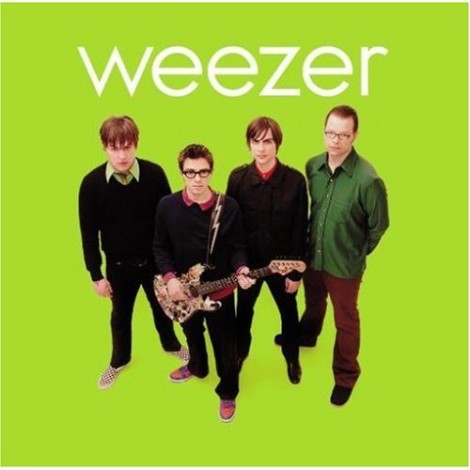 Weezer
Weezer
(2001, DGC/Interscope)
Despite all but one of the original line up returning, you’d still be forgiven for carefully scrutinizing the remaining faces that grace the cover of 2001’s ‘Green’ album…even the band’s logo font is off. It’s an entirely reasonable conclusion that the reformation was purely a business concern. Wilson and Bell had limited success with The Special Goodness and Space Twins, respectively, while Matt Sharp, following the continued friction of a clash of egos with Cuomo, decided to make The Rentals a full-time commitment. Opening track “Don’t Let Go” sounds a little ingenuous, especially given Rivers’ flat, unconvincing delivery.
With the exception of a few songs, the album feels like a cynical attempt at a retread of the Weezer brand: simple catchy melodies with generic lyrics describing ubiquitous situations. Of its ten songs, “Photograph” comes closest to regaining the former glories of ‘Blue’ with Rivers’ incongruous faux-English accent reluctant to pronounce the T’s while adding the odd interesting turn of phrase, such as “If you need it you should show it, cause you might play so monastic that you blow it.” On the whole the album is a crushing disappointment to those who so eagerly awaited Weezer’s return, and with a running time of 28:20, something of an insult too. In spite of its shortcomings, you have to hand it to Cuomo for insisting (against the label’s advice) on re-launching his career with a song about a transvestite prostitute. Idiosyncrasies such as this, as well has his stellar pedigree, kept the hardcore hopeful for its follow-up.
Rating: 5.8 out of 10
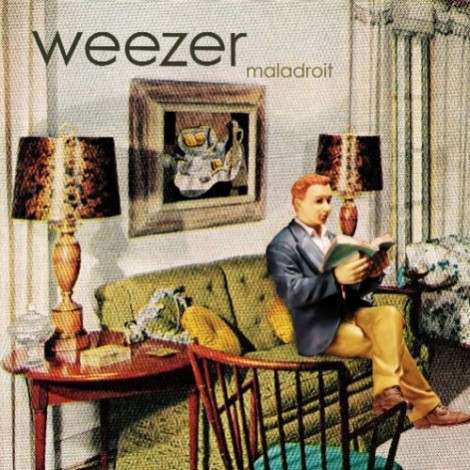 Maladroit
Maladroit
(2002 DGC/Interscope)
Buoyed by Green’s financial success, but having heeded criticisms of a perceived lack of soul, Cuomo entrusted a large part of Maladroit‘s formation to the fans. Written by the band (with new bassist Scott Shriner after Mikey Welsh suffered a mental breakdown), but submitted to committee of their followers via the band’s website and message board: as its title suggests, it doesn’t quite hang together. While far from the unmitigated disaster that some fans regard it as, Maladroit could definitely have benefited from a touch of the discipline and fastidiousness that so stifled ‘Green’.
While its predecessor was shackled to mathematical equations Cuomo had formulated behind the blacked-out windows of his depression bunker following a few false starts at trying to revive Weezer in 1998, Maladroit can’t make up its mind what sort of album it wants to be, flitting as it does between multiple styles sometimes in the space of just one song. In spite of this, it features some of the highest points in the post-reformation catalog. “Keep Fishin’” went back on Cuomo’s post-“Buddy Holly” resistance to relying on gimmicky videos by placing the band on the bill of the ‘Muppet Show,’ and along with “Dope Nose” (any song that contains the line “Cheese smells so good on a burnt piece of lamb/ fag of the year who could beat up your man” is alright by me) gives the album its heavy hitting singles, which while still lacking the charm and idiosyncrasies of it’s counterparts from Blue, are infectious little ditties, and looser and more joyful than anything on ‘Green’, while the ironically titled “Death & Destruction” is the unfulfilled step in the progressive direction this band needed.
Rating: 6.7 out of 10
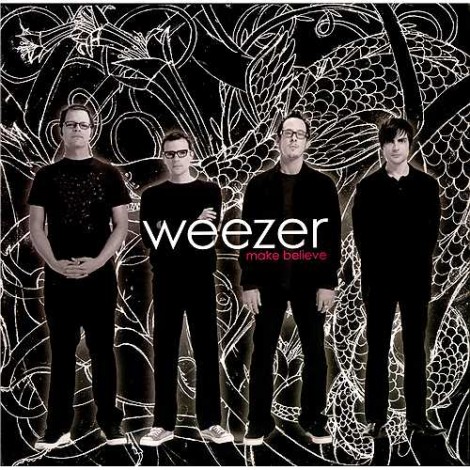 Make Believe
Make Believe
(2005, DGC/Interscope)
With Rick Rubin secured as producer off the back of the triumphant American series of Johnny Cash albums, expectations were unshakably high for Weezer’s fifth outing. Cuomo, under the thrall of his new Svengali, moved into Rubin’s garage and began practicing his brand of meditation (Vispassana). Rubin recommended Rivers look to Neil Young, John Lennon and Trent Reznor as inspiration. The DNA of none of these artists is evident in a record that yielded the desired results for Geffen’s investment in Rubin, but not fans that had invested hope in him corralling the band into a return to the honesty of Pinkerton.
While “Beverly Hills” might on close scrutiny lend itself to ironic or cynical interpretation, Cuomo doesn’t quite wink hard enough into the camera, and you can never get over the banality of it as a piece of music. Second track “Perfect Situation” captures enough of earlier albums earnestness pinned down by the trademark downstrum-chug but feels like a lie in its vapid navel gazing. Cuomo’s later revealed his cynicism by tinkering with this track post-release. Having heard fans who, upon hearing the song for the first time, had uniformly mis-predicted its chorus’s sing-along, Cuomo went back into the studio and re-recorded it accordingly. Despite a few other passable tracks, Make Believe feels every inch another cynical attempt at trying to re-bottle the lightning of their debut, and in “The Other Way” and “My Best Friend” features the band’s first truly odious and irredeemable pop songs.
Rating: 4.1 out of 10
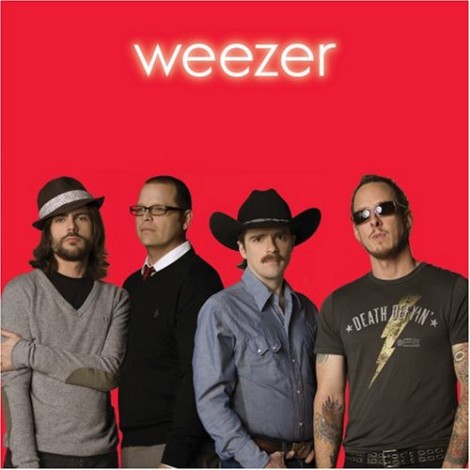 Weezer
Weezer
(2008, DGC/Interscope)
As would become a feature of every release since ‘Green’ a handful of fans forgave the abject disappointment of the previous record and salivated at the prospect of a potential return to form. In the case of Weezer’s sixth album, it wasn’t completely unfounded. Leaked, home-recorded Cuomo demo ‘Pig’, while simple and repetitive used it to good effect, and utilized the right mixture of pathos and absurdity in its lyrics about a farm-reared porcine to surprisingly stirring effect in the tragic inevitability of its death. The ID3 tags had the song as belonging to an album entitled Deliverance at Hand!: Manna from heaven for the beleaguered weezer faithful.
When it was revealed that this album was to be another in the series of self-titled, primary-colored covers, expectations went into overdrive, especially in light of the band’s absurd lineup in front of said red backdrop. Opener “Troublemaker” is ludicrous in its use of just two chords throughout pretty much all of its 2:47, but catchy as Chlamydia, and despite its lunk-headed Highway drivin’ riff, is actually a pretty cerebral antidote to “Beverly Hills” in its outright scathing of celebrity culture. Second track “The Greatest Man That Ever Lived” is as pretentious as it sounds, and for my money the single greatest achievement of the band’s half-life. Chase this with the fine-tuned histrionics of “Pork & Beans” and you have the makings of the return to form the hardcore so long clamored for. Unfortunately ‘Deliverance at Hand’ was more likely a sarcastic reference to the John Boorman movie in conjunction with the Ned Beatty referencing demo, and unfortunately the fans are ultimately delivered swill, and buggered once again by a descent into wishy-washy indifference.
Rating: 5.6 out of 10
 Raditude
Raditude
(2009, DGC/Interscope)
While Red’s title and cover promised riches but ultimately resulted in disappointment, Raditude it was hoped, would result in the reverse, with the dumbest cover and title-combo in recent memory. What it ultimately served-up is a bizarre day-glo foray into Tween-oriented bubblegum rock, which, as hideous as it sounds is almost endearing – unlistenable perhaps, but strangely endearing. Songs such as “The Girl Got Hot” and “I’m Your Daddy” prompted presumably closeted longtime suffering Weezer-apologist Carrie Brownstein of Sleater-Kinney to projectile-bile her fury across the internet.
True, Raditude is stultifyingly juvenile, but does – as amazing as it may sound to anyone who has actually bothered to listen to the album – have some redeeming features. While I think I’ve listened to it a grand total of thrice, I was left with the impression that this might have sounded like the best album my 12-year-old Mallrat self could have ever heard. For this reason, I grant it a certain amount of immunity. First song “(If You’re Wondering If I Want You To) I Want You To” is a perfectly crafted account of relationship awakening, and gets bonus marks for shoehorning a Slayer reference in. While Brownstein’s ire was justifiably fired-up in its assumption these songs were an insult to longstanding Weezer fans, its apparent this album isn’t aimed at them at all. In the midst of it, a pre-incarceration Lil Wayne raps alongside Cuomo on “Can’t Stop Partying”: a sobering pop song about hitting bottom. Presumably it was part of his plea bargain…
Rating: 5.4 out of 10
 Hurley
Hurley
(2010, Epitaph)
Recorded in the run-up to an unprecedented revisit to the two most celebrated records of their career, and spearheaded by a decidedly backward-looking album opener, Hurley pulled the now well-worn trick of the incongruous sleeve, spurring expectations to run wild, though this time rather tiredly. The aftermath of Hurley’s release seems to suggest its dressing was the result of a serendipitous conception. Despite being released on an indie for the first time in Weezer’s 16-year-long recording career, the album’s release ran concurrently with a co-promotional corporate deal with the clothing company of the same name, as they released their line of Weezer-themed apparel. The album cover originated from a chance backstage snap of Cuomo and “Lost” actor Jorge Garcia (who in the show played a character of the same name), firing lightbulbs in Cuomo’s mind.
Once again anticipated as a long-hoped-for return to form, Hurley is, on the whole, more of the same pop posturing. While a little rougher-edged than its predecessor, like them its conception was still mired in collaborations with industry writers for hire. While Cuomo seemingly has no lack of belief in his own abilities, he insists on working with those who, had Weezer’s reformation never come about, he perhaps could have become. As with the albums that came before, Hurley adds negligibly to its forbears while hinting at a return to their former glory but never quite coming near delivering.
Rating: 5.7 out of 10

